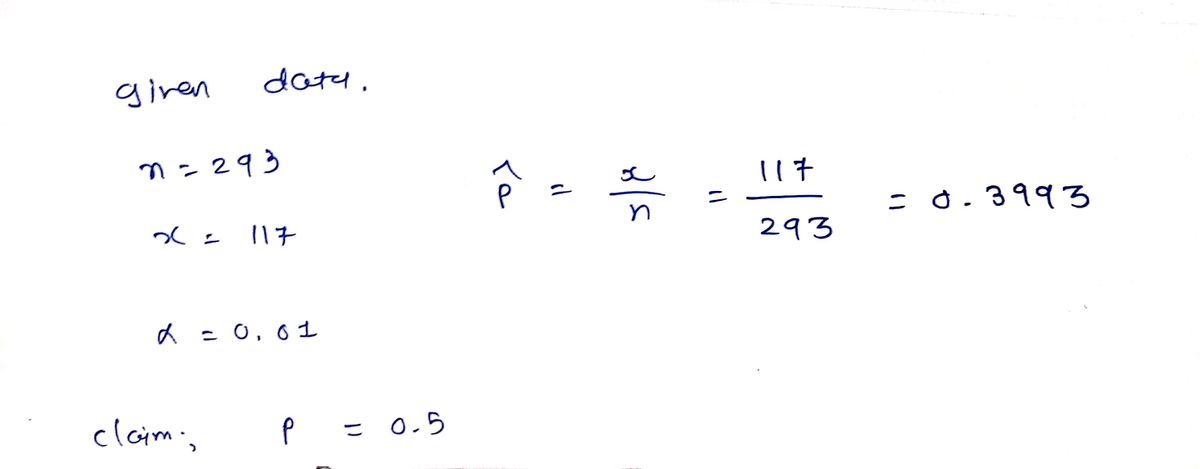A 9-year-old girl did a science fair experiment in which she tested professional touch therapists to see if they could sense her energy field. She flipped a coin to select either her right hand or her left hand, and then she asked the therapists to identify the selected hand by placing their hand just under her hand without seeing it and without touching it. Among 293 trials, the touch therapists were correct 117 times. Use a 0.01 significance level to test the claim that touch therapists use a method equivalent to random guesses. Do the results suggest that touch therapists are effective? Identify the null and alternative hypotheses for this test. Choose the correct answer below. A. Ho: p= 0.5 H1: p#0.5 В. Но: р#0.5 H1:p= 0.5 С. Но: р30.5 O D. Ho: p= 0.5 H1:p<0.5 H1: p>0.5 Identify the test statistic for this hypothesis test. The test statistic for this hypothesis test is (Round to two decimal places as needed.) Identify the P-value for this hypothesis test. The P-value for this hypothesis test is (Round to three decimal places as needed.) Identify the conclusion for this hypothesis test. A. Reject Ho: There is sufficient evidence to warrant rejection of the claim that touch therapists use a method equivalent to random guesses. B. Fail to reject Ho. There is sufficient evidence to warrant rejection of the claim that touch therapists use a method equivalent to random guesses. O C. Reject Ho. There is not sufficient evidence to warrant rejection of the claim that touch therapists use a method equivalent to random guesses. D. Fail to reject Ho. There is not sufficient evidence to warrant rejection of the claim that touch therapists use a method equivalent to random guesses. Do the results suggest that touch therapists are effective? random guesses, so they (2) The results suggest that the touch therapists performed (1) to be effective. (1) O worse than (2) do not appear better than appear O similarly to
A 9-year-old girl did a science fair experiment in which she tested professional touch therapists to see if they could sense her energy field. She flipped a coin to select either her right hand or her left hand, and then she asked the therapists to identify the selected hand by placing their hand just under her hand without seeing it and without touching it. Among 293 trials, the touch therapists were correct 117 times. Use a 0.01 significance level to test the claim that touch therapists use a method equivalent to random guesses. Do the results suggest that touch therapists are effective?
Identify the null and alternative hypotheses for this test. Choose the correct answer below.
A. H0:p=0.5 H1: p≠0.5
C. H0:p=0.5 H1: p<0.5
Identify the test statistic for this hypothesis test.
The test statistic for this hypothesis test is (Round to two decimal places as needed.)
Identify the P-value for this hypothesis test.
The P-value for this hypothesis test is (Round to three decimal places as needed.)
Identify the conclusion for this hypothesis test.
B. H0:p≠0.5 H1: p=0.5
D. H0:p=0.5 H1: p>0.5
.
.
A. Reject H0. There is sufficient evidence to warrant rejection of the claim that touch therapists use a method equivalent to random guesses.
B. Fail to reject H0. There is sufficient evidence to warrant rejection of the claim that touch therapists use a method equivalent to random guesses.
C. Reject H0. There is not sufficient evidence to warrant rejection of the claim that touch therapists use a method equivalent to random guesses.
D. Fail to reject H0. There is not sufficient evidence to warrant rejection of the claim that touch therapists use a method equivalent to random guesses.
Do the results suggest that touch therapists are effective?
The results suggest that the touch therapists performed (1) random guesses, so they (2) to be effective.
(1) worse than (2) do not appear better than appear similarly to


Step by step
Solved in 2 steps with 2 images









